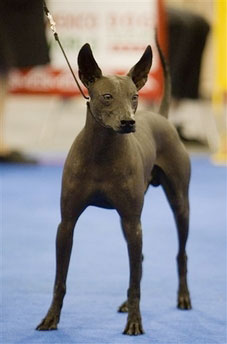Americas
Hairless breed shines at dog show
(AP)
Updated: 2007-05-26 17:33
 |
Large Medium Small |
MEXICO CITY - The star of the World Dog Show is not the soulful Labrador, the bulldog with attitude or even the manic Chihuahua. This year, the hairless Xoloitzcuintles (show-low-ee-SQUINT-lees) are stealing the show in their native Mexico.
 A Mexican Xoloitzcuintle Intermedio, is seen prior to compete in the Mexico World Dog Show 2007 in Mexico City, Thursday, May 24, 2007. [AP]  |
Nicknamed "Xolos" by breeders and known in Mexico as "Itzcuintles," the breed has yet to come into its own. But the dogs are becoming more popular around the world. They can sell for up to $2,500 for a show dog, and past owners have included the Mexican artists Diego Rivera and Frida Kahlo.
Breeders say Xolos were on their way to extinction in the 1940s when a group of Mexicans began searching for the dogs in remote, mountain villages and forgotten desert outposts, building a breed that numbers around 5,000 worldwide today.
Patty Hoover, a breeder from Selah, Wash., said she began breeding Xolos almost 20 years ago because she "married a man who didn't like dog hair on the floor."
There weren't many other Xolo owners around when she started, but that is changing.
"They are getting a lot more recognition," she said, videotaping Xolos as they pranced by at a Mexico City convention center. "The breeders are working really hard to promote them."
Stephanie Mazzarella, an asthmatic 44-year-old from Loxahatchee, Fla., began breeding them after her doctor told her she could never have a pet -- unless it had no hair. Now, she spends her free time trying to get others interested in her dogs.
"I put them in a puppy stroller and take them to the mall to try to get the public interested," she said as her 9-month-old puppy, Chabella, watched his competitors.
Xolos were common throughout Mexico at the time of the Spanish Conquest. They were considered sacred by the Aztecs, who sometimes ate their meat as a cure-all for illness or buried the dogs with their owners to help guide the human spirit to the afterlife. The dogs are still believed by many to have healing qualities.
Brenda Armstrong, who has four Xolos at home in Vancouver, British Columbia, said she had a friend whose Xolo was trained to wake her up if her diabetic husband's blood sugar fell in the night.
"Mayan women still hold the dogs up to their stomachs to cure cramps," she said, playing with the leash of her friend's Xolo at the show.
Some 70 Xolos are competing in this weekend's World Dog Show. It remains to be seen whether the Xolo selected as best of breed can hold its own against the more than 5,000 dogs and 300 breeds competing Sunday for "best of show."
Even if they don't win, the Xolos have taken center stage in a sea of Great Danes, German Shepherds and fluffy lap dogs.
The dogs have long been popular in rare-breed dog shows, and can be found as pets around the world. Russians dress them in special down coats, while Mexicans slather light-skinned Xolos in sunscreen.
The dogs have warm, soft skin, and keep their coat oiled with glands found between their toes.
Some have a wiry shock of hair at the top of their head, and about 25 percent are actually born with a thick coat of fur, a genetic quirk.
Xolos range in weight from 10 to 50 pounds and come in three different sizes: mini, a little larger than a Chihuahau; intermediate, about the size of a beagle; and standard, roughly the size of a Labrador.
Armstrong says the breed is hearty, having survived thousands of years in Mexico. Once, her dog ate two barrel cactuses.
"I thought, 'Oh, this is going to be expensive,' " she said. "But somehow she didn't have one spine in her mouth, and an hour later she coughed up all the spines and she had no trouble digesting the cactus."
| 分享按钮 |